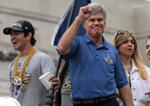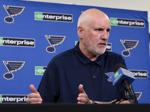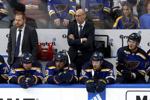The Blues missed the playoffs for the second straight season. That hasn’t happened since the 2009-11 span, so these are tough days for a proud organization. From the ownership to the business operation to the hockey operation, this franchise is committed to avoiding the sort of long-haul rebuild Detroit Red Wings fans endured and the Chicago Blackhawks fans are experiencing now. But that challenge is severely testing everybody from Tom Stillman on down.

Blues owner Tom Stillman waves to the crowd during the team's Stanley Cup victory parade on Saturday, June 15, 2019, in downtown St. Louis.
Under Stillman’s ownership group, the Blues have consistently spent to the NHL salary cap to maintain a competitive roster. The cap is going up for next season and there is every indication that the Blues will spend to the limit again. As general manager Doug Armstrong noted, the ownership has never said “no” to his request to commit money to a big personnel move.
Stillman has remained supportive of Armstrong despite the team’s downturn after its magical Stanley Cup run, and he shares Armstrong’s vision for the next few years. The Blues will try to remain competitive while retooling around Robert Thomas and Jordan Kyrou, their two cornerstone forwards, and their strong goaltending.
People are also reading…
The ownership has no appetite for a painful tank-and-rebuild process that could produce multiple seasons of abject failure. That approach could kill attendance, produce staggering revenue decline and endanger the franchise’s long-range future in the STL. Committed ownership is great ownership.
Management

"We’re trying to do something that’s difficult, which is stay competitive and find good players and make good trades and win a championship,” Blues general manager Doug Armstrong said while speaking at a season-ending news conference on Thursday, April 18, 2024, at Centene Community Ice Center in Maryland Heights.
The Blues came back with largely the same crew they finished with last season, after the franchise sold off several key players with expiring contracts and rounded up some a stopgap players to fill holes.
Armstrong hoped that the Blues could finish in the upper tier of the middle third of the Western Conference. He came to regret setting such a realistic ceiling for the team this season, but that was a refreshingly realistic and honest assessment. What his projection didn’t count on was the Winnipeg Jets reversing course and locking up goaltender Connor Hellebuyck while redoubling its commitment to its veteran core.
With the Jets eschewing a rebuild, the Blues’ path to a potential third-place finish in the Central Division was blocked. And as it turned out, this team was not quite ready to realize its full potential.
Armstrong tried to shake up his aging defensive corps by adding Travis Sanheim and subtracting Torey Krug with an offseason trade with the Flyers. Not surprisingly, Krug wanted no part of moving to Philadelphia and then likely getting flipped to still another team. He used his no-trade protections to block that trade.
After that development. Armstrong struck lesser deal that landed forward Kevin Hayes from Philadelphia. Hayes had three years remaining on a contract carrying a $7.143 million salary cap hit. The Flyers ate half of that money to make the trade, but Hayes failed to provide the third-line depth scoring Armstrong hoped to secure.
Even with a $3.571 million cap hit, the Hayes contract joined the Krug and Justin Faulk salary cap hits (at $6.5 million each) as excessive for a franchise attempting to retool on the fly.
When the Blues stumbled to a 13-14-1 start this season, Armstrong fired beloved coach Craig Berube and promoted Drew Bannister from his AHL post to become interim head coach. That change, painful as it was, spurred the Blues' reversal that kept them in the playoff chase until the final weekend.
With no attractive offers coming his way, Armstrong stood pat at the trade deadline and shifted his focus to developing key younger players already in the organization. The Blues got a head start on next season by giving more playing time to up-and-comers like defenseman Matt Kessel and winger Zack Bolduc.
The bottom line for Armstrong: His one big move, for Hayes, was a whiff. His coaching change, while inevitable at some point, was a bitter pill for the fan base to swallow.

St. Louis Blues interim head coach Drew Bannister watches the second period of a game against the Seattle Kraken on Sunday, April 14, 2024, at Enterprise Center in St. Louis. The Blues defeated the Kraken, 4-1.
Armstrong made one big adjustment ahead of the season, replacing assistant coach Mike Van Ryn with Mike Weber to oversee the defense. That change had a positive impact on the blue line, despite Krug’s ongoing struggles and Faulk’s injury-related regression.
The Blues’ power play struggled mightily under Berube, which helped doom Chief to his December dismissal. After Bannister’s promotion, Armstrong added Brad Richards as a power-play consultant and the team made positive strides with the man advantage.
Bannister did a nice job under tough circumstances. The Blues seemed ready to buckle a few times down the stretch, but each time he and his assistant coaches prodded the team back on track.
Had this team earned all their potential points against the NHL’s worst teams this season, it could have squeezed into the playoff bracket. Ultimately, though, the Blues just weren’t that good this season. They were not a true playoff-caliber team. They outperformed their predictive metrics because they got great goaltending.
Bannister raised his coaching profile with his interim effort. Whether he did enough to keep the head coaching job here remains to be seen.
"difficult" - Google News
April 26, 2024 at 10:00PM
https://ift.tt/EJv2Qa8
Gordo grades Blues ownership, management, coaches: Retooling proves difficult - St. Louis Post-Dispatch
"difficult" - Google News
https://ift.tt/L8Uljer
https://ift.tt/tdSCMck
Bagikan Berita Ini














0 Response to "Gordo grades Blues ownership, management, coaches: Retooling proves difficult - St. Louis Post-Dispatch"
Post a Comment